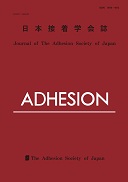All issues

Volume 41, Issue 9
Displaying 1-4 of 4 articles from this issue
- |<
- <
- 1
- >
- >|
Review
-
Kazushi KIMURA, Jiro WATANABE, Keisuke TINO2005Volume 41Issue 9 Pages 365-370
Published: September 01, 2005
Released on J-STAGE: September 30, 2015
JOURNAL FREE ACCESSDownload PDF (2286K)
Review
-
Hiroo MIYAIRI2005Volume 41Issue 9 Pages 360-364
Published: September 01, 2005
Released on J-STAGE: September 30, 2015
JOURNAL FREE ACCESSDownload PDF (1595K)
Technical Report
-
Yukio DOI, Akira ISHII, Yasushi ICHIKAWA, Yoshiro OKINO2005Volume 41Issue 9 Pages 353-359
Published: September 01, 2005
Released on J-STAGE: November 30, 2014
JOURNAL FREE ACCESSThe preparation of biodegradable polyester emulsion was investigated using three types of emulsificationequipments:The first is a mixer which has one turbine stirrer and two blades to rotate and revolve simultaneously to attain efficiently homogeneous agitation even in highly viscous systems. (abbreviated to planetary-type mixer). The second is a homogenizer in which dispersion is effected by forcing the mixture to be emulsified through a small interstice made by Ramond unite under very high pressure (abbreviated to Ramond mixer). The third is an extruder with twin screws to rotate in the same direction.Polycaprolactone was dissolved in toluene and emulsified by the planetary-type mixer and the Ramond mixer, whereas polybutylene succinate-co-adipate was fed in the extruder as pellet. Partially saponificated polyvinyl alcohol was selected as emulsifier.Our porpose is to establish the easy emulsification technique to prepare biodegradable polyester emulsion whose particle diameter is ca. 1μm and which results in durable film to water. The following results were obtained.1. The easy emulsificaiton technique means that the emulsification proceeds smoothly up to the final state without any troublesome operation to maintain agitation homogeneously. This was attained using the three equipments.2. Ca. 1μm diameter and water durable film are the least requirement for polymer emulsion adhesives. The former was attained with the planctary-type mixer and with the Ramond mixer, but the smallest diameter was not, smaller than 2μm with the extruder. The latter was obtained with the extruder, but the other two mixers resulted in films to be disintegrated in water.3. The correlations between the particle size and emulsification parameters were found quantitatively and it is concluded that the flow rate in the Ramond mixer and the feeding rate in the extruder are the most influential parameters. Therefore, using these informations we may expect that our initial purpose can be attained.View full abstractDownload PDF (1975K)
Original Paper
-
Hajime KISHI, Akira FUJITA, Hikaru MIYAZAKI, Satishi MATSUDA, Atsushi ...2005Volume 41Issue 9 Pages 344-352
Published: September 01, 2005
Released on J-STAGE: November 30, 2014
JOURNAL FREE ACCESSWood-based thermoset epoxy resins were newly synthesized from liquefied wood as resin precursor. First, wood meal was liquefied by the reaction with phenol or resorcinol. The liquefied wood were considered as precursors for synthesizing epoxy resins, because they included considerable amount of hydroxyl groups as reactive sites. Then, glycidyl etherification of the phenolic-OH groups was employed as the synthesizing route for epoxy resins. Resorcinol-liquefied wood-based epoxy resin had higher epoxy functionality than phenol-liquefied wood-based epoxy resin. The epoxy functionality of the resins was controlled by the concentration of phenolic-OH groups in liquefied wood, and that was considered as a dominant factor for crosslink density and mechanical properties of the cured epoxy resins. The flexural strength (150~180MPa) and the modulus of elasticity (3.2GPa) of the wood-based cured epoxy resin were equivalent to those of commercial-based bisphenol-A type epoxy resin.View full abstractDownload PDF (2950K)
- |<
- <
- 1
- >
- >|